Joseph Orville Shelby
(December 12, 1830 - February 13, 1897)
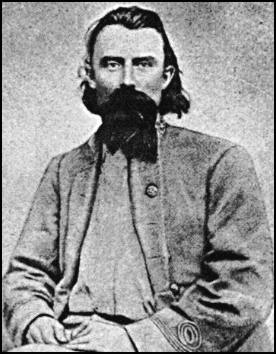 On his deathbed, former Union Major General Alfred Pleasonton would say, "Shelby was the best cavalry general of the South. Under other conditions, he would have been one of the best in the world."
On his deathbed, former Union Major General Alfred Pleasonton would say, "Shelby was the best cavalry general of the South. Under other conditions, he would have been one of the best in the world."
Joseph "Jo" Shelby was a wealthy businessman living in Waverly, Missouri when the American Civil War broke out. Shelby recruited many individuals to fight for the Southern cause and would rise to the rank of Brigadier General in command of a Cavalry Division for the Confederates.
Shelby refused to surrender at the end of the war and went to Mexico for two years before returning to Missouri.
Pre-Civil War Role
Joseph Orville "Jo" Shelby was born to a wealthy family in Lexington, Kentucky. In 1852, he moved to Waverly, Missouri and started a business to make rope for baling cotton. He owned slaves and a large farm. During the Bleeding Kansas years, Shelby raised a cavalry company and took the fight to Kansas on the pro-slavery side.
Civil War Role
After the "Camp Jackson" affair, Shelby returned to Waverly and raised a cavalry company for service in Missouri under the command of Brigadier General James S Rains. He was elected the Captain of Shelby's Company of Rangers.
After participating in the battles of Carthage, Wilson's Creek, Lexington, Pea Ridge and Corinth, Shelby secretly returned to Missouri and raised a cavalry company. They were sworn into the Confederate army on July 1, 1862. Again Selby was elected the company's Captain.
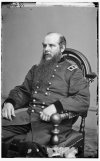
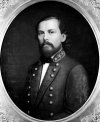 On July 22, 1862, Brigadier General John M. Schofield, commander of the Department of Missouri, issued General Order Number 19 which required "every able-bodied man capable of bearing arms and subject to military duty...to repair without delay to the nearest military post and report for duty." On August 4, 1862, Schofield issued General Order Number 24 which required disloyal men and those that sympathized with the rebellion to report to the nearest enrolling station to be enrolled and to surrender their arms. In Little Rock, Arkansas Confederate Brigadier General T. C. Hindman issued General Order Number 17 which legitimized guerrilla bands in the service of the C.S.A. All of these actions assisted Shelby's recruiting efforts. Shelby asked for and received permission to go to the Missouri River to raise a regiment. He was promoted to Colonel on July 28th.
On July 22, 1862, Brigadier General John M. Schofield, commander of the Department of Missouri, issued General Order Number 19 which required "every able-bodied man capable of bearing arms and subject to military duty...to repair without delay to the nearest military post and report for duty." On August 4, 1862, Schofield issued General Order Number 24 which required disloyal men and those that sympathized with the rebellion to report to the nearest enrolling station to be enrolled and to surrender their arms. In Little Rock, Arkansas Confederate Brigadier General T. C. Hindman issued General Order Number 17 which legitimized guerrilla bands in the service of the C.S.A. All of these actions assisted Shelby's recruiting efforts. Shelby asked for and received permission to go to the Missouri River to raise a regiment. He was promoted to Colonel on July 28th.
Shelby returned with his recruited regiment and met General Hindman near Pineville, Missouri. On September 12, 1862 Hindman appointed Shelby to command a brigade (2,319 men) made up of his regiment and the regiments of Colonel John T. Coffee and Colonel Upton Hays. At this time, Shelby formed a two gun artillery battery under the command Captain Joseph Bledsoe. Lieutenant Richard A. Collins joined the battery at this time. Most of the men in this brigade were moderate Missourians who had been forced to take sides as a result of Schofield's General Order Number 19.
On September 30, 1862, Shelby's Brigade participated in the First Battle of Newtonia (Missouri) which would end with a Confederate victory when the Federals withdrew from the field of battle.
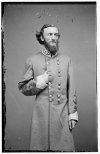 Shelby's Brigade participated in the Prairie Grove Campaign in late 1862. He commanded 1,100 effectives in Brigadier General John S. Marmaduke's Fourth Cavalry Division (2,300 men) supporting Major General Thomas C. Hindman's First Corps (9,000 infantry) of the Trans-Mississippi Army. On December 7, 1862, Shelby's Brigade fought in the Battle of Prairie Grove. During the battle, Shelby had traveled with an inadequate escort and was momentarily captured by the Federals. Shelby's Brigade distinguished themselves during this battle. Shelby's reputation as one of the south's best cavalry commanders continued to grow.
Shelby's Brigade participated in the Prairie Grove Campaign in late 1862. He commanded 1,100 effectives in Brigadier General John S. Marmaduke's Fourth Cavalry Division (2,300 men) supporting Major General Thomas C. Hindman's First Corps (9,000 infantry) of the Trans-Mississippi Army. On December 7, 1862, Shelby's Brigade fought in the Battle of Prairie Grove. During the battle, Shelby had traveled with an inadequate escort and was momentarily captured by the Federals. Shelby's Brigade distinguished themselves during this battle. Shelby's reputation as one of the south's best cavalry commanders continued to grow.
In an attempt to relieve the pressure by Grant on Vicksburg, Mississippi, Lt. General Theophilus H. Holmes planned an attack on the Union held town of Helena, Arkansas. Shelby's Brigade was part of Brigadier General John S. Marmaduke's Fourth Cavalry Division which was to attack Helena from the north. The Confederate attack on July 4, 1863 was a miserable failure, and Shelby was severely wounded during the fighting. After being patched up, Shelby called for volunteers to save his brigade's battery from capture. Shelby's Iron Brigade also protected Marmaduke's withdrawal from the field of battle.
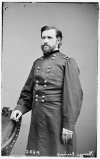 While Shelby was still recuperating from his wound in Batesville, Arkansas, he received word from Missouri that his family had been among those displaced by Brigadier General Thomas Ewing's General Order Number 11. Shelby contacted Union General Frank Blair, who made arrangements for Shelby's family to go to the Shelby home in Lexington, Kentucky.
While Shelby was still recuperating from his wound in Batesville, Arkansas, he received word from Missouri that his family had been among those displaced by Brigadier General Thomas Ewing's General Order Number 11. Shelby contacted Union General Frank Blair, who made arrangements for Shelby's family to go to the Shelby home in Lexington, Kentucky.
Shelby's Great Raid into Missouri during September and October of 1863 was the most daring of all the Civil War cavalry raids. Shelby asked for and received permission to go on the raid from Missouri Governor in exile Thomas C. Reynolds. His objective was a quick strike through Missouri to Jefferson City in order to jolt the Confederacy into realizing the importance and vulnerability of Missouri. His superiors in the Confederate Army of the Trans-Mississippi fully expected Shelby to be captured in Missouri. He started with 800 men and returned with twice as many men having recruited many to the cause of the Confederacy. You may find it interesting that William Quantrill's company of Missouri Partisan Rangers was part of this raid. Shelby's raid covered over 1,500 miles and cost the federal government a million dollars in destroyed supplies. As a result of this successful raid, Shelby received a promotion to Brigadier General on December 15, 1863.
In the spring of 1864, Union General Nathaniel P. Banks received permission from Grant to mount an expedition (Red River Campaign) against Shreveport, Louisiana. Banks would be supported by gunboats under the command of Admiral Porter. To support Banks, Sherman sent General Frederick Steele from Little Rock to assist Banks and attack Shreveport from the north. Shelby was given the task of preventing Steel from reaching Shreveport. Although outnumbered 12 to 1, Shelby would fight Steele over a 2 week period, place him under siege at Camden, Arkansas, and force him back to Little Rock.
Jo Shelby was 33 years old in 1864 during Price's Raid into Missouri. His division consisted of three brigades, including the famous Iron Brigade, probably the best Confederate cavalry outfit west of the Mississippi River. At the Battle of Byram's Ford on the Big Blue River, Shelby broke through the Federal defenses and sent them reeling west to Westport. During the next day's Battle of Westport, after Shelby's position was flanked by the Federals and Marmaduke was routed at Byram's Ford on the Big Blue River, Shelby set up a line of defense just south of Kansas City that saved Price's army from destruction. During Price's retreat south after his defeat at the Battle of Westport, Shelby fought several rear guard actions to save Price's Army from being destroyed or captured. Major General Sterling Price had this to say about Shelby in his official report on the Missouri Expedition:
"Brig. Gen. Shelby, commanding division, added new luster to his past fame as a brilliant and heroic officer, and without disparagement to the other officers I must be permitted to say that I consider him the best cavalry officer I ever saw."
Though Shelby was brilliant, the failure of Price's Missouri Expedition was so complete that the Confederate Army of the Trans-Mississippi never fired another shot Through the end of the war.
In the spring of 1865, Shelby had a plan to save the Confederacy from defeat. He wanted to get Simon Bolivar Buckner placed in command of the Army of the Trans-Mississippi and form an alliance with Mexico. He felt the South could provide 75-100 thousand veterans in this alliance. Combined with an equal number from Mexico, he believed such an army could force a negotiated peace with the United States. The grand plan would be to create a larger, stronger Confederacy in the Southwest. It never came to fruition.
Shelby became a General without an army when Kirby Smith surrendered the Army of the Trans-Mississippi on May 26, 1865. This officially ended hostilities west of th Mississippi River.
Post-Civil War Role
Jo Shelby was the only active commander in the Confederate Army that never surrendered at the end of the war. After Kirby Smith surrendered, Shelby told his men on June 1st that he was not going to surrender but was going to Mexico. Most of Shelby's men surrendered and were able to return to their homes in Missouri. Between 150 and 500 men chose to go to Mexico with Shelby.
Shelby returned two years later to his home in Lexington, Kentucky in June 1867. He would farm for several years and be involved in business ventures in Missouri. Dating back to the war years, Shelby was friends with Frank and Jesse James. Shelby testified at Frank James trial in August 1883
In 1893, President Grover Cleveland appointed Shelby as U.S. Marshal for the Western District of Missouri in 1893
Jo Shelby, Missouri's greatest warrior, died in Adrian, Missouri in 1897 and is buried in Kansas City's Forest Hill Cemetery.
Sites of Interest
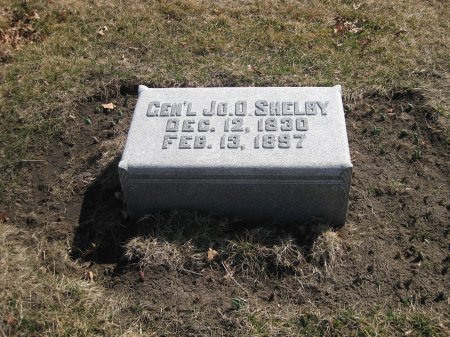 Shelby Grave - Forest Hill Cemetery, 6901 Troost Ave., Kansas City, MO, 64131
Shelby Grave - Forest Hill Cemetery, 6901 Troost Ave., Kansas City, MO, 64131
| Waypoint = N38 59.984 W94 34.150 |
References
- Monaghan, Jay. Civil War on the Western Border, 1854-1865
Lincoln: University of Nebraska Press, 1955.
- Monnett, Howard N. Action Before Westport 1864, Revised Edition
Boulder: University Press of Colorado, 1995
- O'Flaherty, Daniel. General Jo Shelby: Undefeated Rebel
Chapel Hill: University of North Carolina Press, 1954.
- Sellmeyer, Deryl P. Jo Shelby's Iron Brigade
Gretna, La.: Pelican Pub. Co., 2007.
Back: James Fleming Fagan
Next: James G. Blunt
